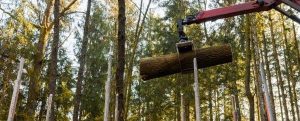 PRINCE GEORGE – The BC government is taking action to make sure more people benefit from timber harvesting in the Prince George Timber Supply Area (TSA).
PRINCE GEORGE – The BC government is taking action to make sure more people benefit from timber harvesting in the Prince George Timber Supply Area (TSA).
As part of a new apportionment decision, the role that First Nations play in the area’s forest economy will be enhanced. With this change, government will be able to provide more forest tenure to First Nations. This will also result in mutually beneficial partnerships and agreements between industry and First Nations.
“Over the past six months, the ministry has engaged with forest companies, local governments and stakeholders regarding this apportionment,” said Katrine Conroy, Minister of Forests, Lands, Natural Resource Operations and Rural Development. “I have considered the interests expressed by those groups as well as the input of First Nations in making this apportionment decision.”
Reductions in timber supply, changing global markets for forest products, combined with provincial interests in advancing reconciliation, are making apportionment decisions more complex. This decision is intended to create more stability and increase investment in the forest sector.
This apportionment increases the percentage of the allowable annual cut (AAC) available for First Nations in the Prince George TSA from 3.6 per cent, as established in 2012, to 14.9 per cent. This new allotment intends to give more access to tenure agreements to a wider group of businesses and First Nations.
“The Carrier Sekani First Nations fully support this important decision by Minister Conroy,” said Mina Holmes, Tribal Chief for the Carrier Sekani First Nations. “We are now beginning to abide by the principles set out in the United Nations Declaration on the Rights of Indigenous Peoples and the BC Declaration Act. This presents an opportunity to strike a new path together and bring real reconciliation to our region.”
The new apportionment maintains the AAC for the forest-licence category at the same benchmark set in 2004, which was approximately 60 per cent of the AAC in a given TSA. This level is based on the AAC that sees continuous harvest performance and is considered stable and relatively long term in nature.
In 2017, BC’s chief forester reduced the AAC for the Prince George TSA by 33.2 per cent. This was in response to the temporary increase to the AAC between 2004 and 2012, which was created to manage the impacts of the mountain pine beetle.


